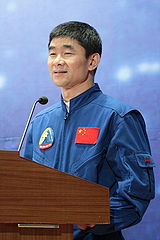cosmos.wikisort.org - Cosmonaut
Liu Boming (simplified Chinese: 刘伯明; traditional Chinese: 劉伯明; pinyin: Liú Bómíng; born September 17, 1966) is a major general in the Chinese People's Liberation Army Strategic Support Force (PLASSF). A fighter pilot in the PLA Air Force (PLAAF), he was selected into the PLA Astronaut Corps (PLAAC) in 1998. A Shenzhou 7 veteran, he also worked on the Tiangong space station during the Shenzhou 12 mission from June to September 2021.
Liu Boming | |
|---|---|
 Liu Boming speaking at the Chinese University of Hong Kong | |
| Born | September 17, 1966 (age 56) Nenjiang, Heilongjiang, China |
| Alma mater | |
| Space career | |
| PLAAC Astronaut | |
Previous occupation | |
| Rank | Major general, PLASSF |
Time in space | 95 days and 29 minutes |
| Selection | Chinese Group 1 |
Total EVAs | 3 |
Total EVA time | 13 hours 03 minutes[1] |
| Missions | Shenzhou 7, Shenzhou 12 |
With a combined total of three EVA's performed, he spent some 13 hours walking in space which is currently the record by a Chinese astronaut.
Astronaut Corps career
Liu, along with Zhai Zhigang and Jing Haipeng, was chosen to be the main crew of Shenzhou 7, with Zhai as commander, on 17 September 2008. On 25 September, at 21:10 CST, they launched into space as China's third human spaceflight mission, and the first Chinese mission ever to have a three-man crew.[2] Liu and Zhai participated in China's first-ever space walk.
Liu wore a Russian Orlan-M spacesuit, while Zhai wore the Chinese-made Feitian space suit. Liu remained in the open portal of the orbital module, assisting Zhai on his spacewalk; later in the space walk, Liu also performed a stand-up extra-vehicular activity, partially leaving the orbital module in order to hand Zhai a Chinese flag.[3] After the spacewalk, Liu said in an interview that his inspiration and idols have always been Neil Armstrong and Yuri Gagarin.[4]
In 2018, he became as PhD candidate at Beijing Institute of Technology.[5]
On 17 June 2021, Liu flew on Shenzhou 12 as his second spaceflight, becoming one of the three initial crew members to enter the Tiangong space station.[6][7] On 4 July 2021, Liu and Tang Hongbo, another crew member of Shenzhou 12, completed the first extravehicular activity of the Tiangong space station.[8] On 20 August 2021, Liu and mission commander Nie Haisheng carried out the second extravehicular activity of the space station,[9] making him the first Chinese national to perform extravehicular activities multiple times.
See also
- List of Chinese astronauts
References
- "Liu Boming - EVA experience". 20 August 2021. Retrieved 20 August 2021.
- Hu, Yinan; Xin, Dingding (26 September 2008). "Shenzhou VII launched for 1st spacewalk". China Daily. Jiuquan; Beijing. Retrieved 9 August 2018.
- McDowell, Jonathan (29 September 2008). "JSR No. 601 draft". Jonathan's Space Report. Retrieved 29 September 2008.
- Wu, Bing; Sun, Dejun; Wang, Bing; Liu, Lifang; Zhe, Danzhu; Jia, Xubo (24 September 2008). "刘伯明:阿姆斯特朗是我的偶像" [Liu Boming: Neil Armstrong is my idol]. People.com.cn. Archived from the original on 27 January 2018. Retrieved 9 August 2018.
- "神舟十二号飞天,这些高校"挑大梁"" (in Chinese). 高校科技. 18 June 2021.
- "China unveils Shenzhou-12 astronauts for space station construction". 16 June 2021. Retrieved 16 June 2021.
- Clark, Stephen (17 June 2021). "Chinese astronauts enter Tiangong space station for first time". Spaceflight Now. Retrieved 17 June 2021.
- "Shenzhou XII crew successfully conclude first spacewalk". China Daily. 4 July 2021. Archived from the original on 4 July 2021. Retrieved 4 July 2021.
- "神舟十二号航天员乘组圆满完成第二次出舱活动全部既定任务 计划9月中旬返回". xinhuanet.com. 20 August 2021.
External links
- Liu Boming at the Encyclopedia Astronautica. Accessed 23 July 2005.
- Spacefacts biography of Liu Boming
На других языках
[de] Liu Boming
Liu Boming (chinesisch .mw-parser-output .Hant{font-size:110%}劉伯明 / .mw-parser-output .Hans{font-size:110%}刘伯明, Pinyin Liú Bómíng; * 29. Oktober 1966 in Yi’an, Provinz Heilongjiang, Volksrepublik China) ist ein chinesischer Kampfpilot und Raumfahrer.[1]- [en] Liu Boming (taikonaut)
[fr] Liu Boming
Liu Boming est un pilote de chasse chinois sélectionné comme astronaute pour participer au programme Shenzhou en 1998.[it] Liu Boming
Liu Boming[1] (in cinese semplificato: 刘伯明; in cinese tradizionale: 劉伯明;) (Heilongjiang, 29 ottobre 1966) è un astronauta cinese.[ru] Лю Бомин
Лю Боми́н (кит. упр. 刘伯明, пиньинь Líu Bó Míng) (род. 16 сентября 1966, Иань, Хэйлунцзян, КНР) — китайский космонавт.Другой контент может иметь иную лицензию. Перед использованием материалов сайта WikiSort.org внимательно изучите правила лицензирования конкретных элементов наполнения сайта.
WikiSort.org - проект по пересортировке и дополнению контента Википедии